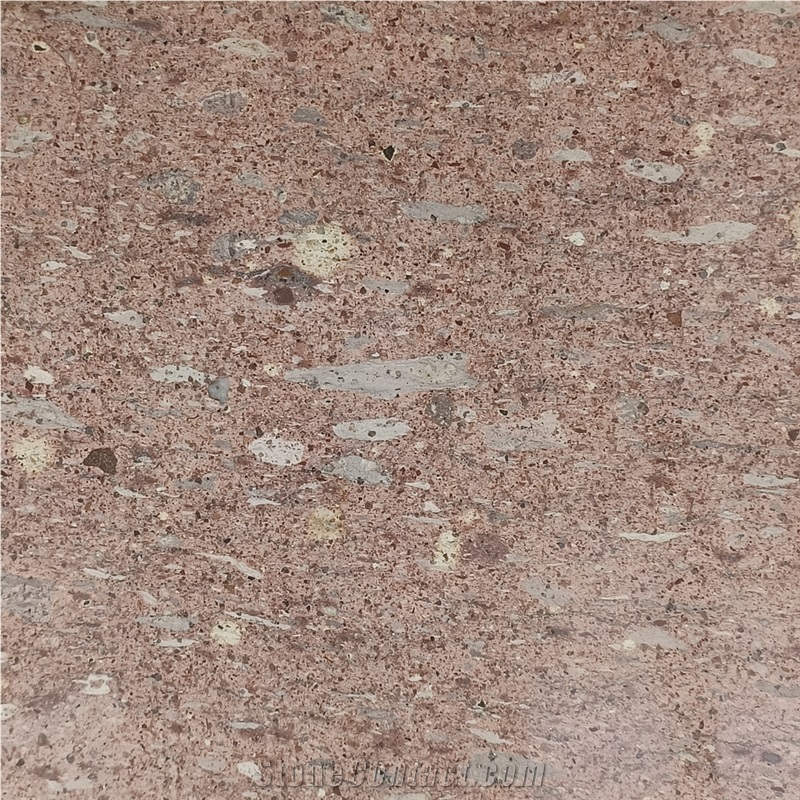Sahara Rose Andesite
 China
(Tiantai County, Shaoxing, Zhejiang Province)
China
(Tiantai County, Shaoxing, Zhejiang Province)
Sahara Rose Andesite is a distinctive volcanic stone characterized by its subtle, elegant color palette and durable structure, making it suitable for both interior and exterior architectural applications. It is believed to be quarried in Tiantai County, Shaoxing, Zhejiang Province, China, an area known for its quality andesite and basalt resources.
Description of Sahara Rose Andesite
Color
- Primary: Rosy-beige
- Secondary tones:Grayish shades, soft pink undertones
- Occasionally includes muted brown or taupe accents depending on the mineral content and weathering.
Texture
- Fine to medium grain
- Typically aphanitic (individual grains are microscopic and not visible to the naked eye)
- May develop porphyritic texture if cooled slowly—visible phenocrysts (e.g., feldspar, pyroxene) embedded in a finer groundmass
Pattern
- Subtle, uniform coloration
- Minimal veining
- May show occasional mineral flecks or crystalline speckles when cut or polished
Physical & Mechanical Properties
(Values may slightly vary depending on quarry block, specific test method, and density)
- Density : ~2.61 – 2.74 g/cm³
- Water Absorption : ~0.45 – 1.20%
- Porosity : ~1.0 – 4.5%
- Compressive Strength : ~110 – 180 MPa
- Flexural Strength : ~12 – 21 MPa
- Abrasion Resistance : High (ASTM C241: ~20–25 mm³ loss)
- Mohs Hardness : 6 – 7
- Slip Resistance (Dry) : R11 – R13 (DIN 51130 / ASTM C1028)
- Slip Resistance (Wet) : R10 – R12
Chemical Composition (% by weight)
(Typical for andesitic volcanic rocks)
- SiO₂ (Silica) : 58 – 63%
- Al₂O₃ (Alumina) : 15 – 18%
- Fe₂O₃ (Iron Oxide) : 5 – 8%
- CaO (Calcium Oxide) : 4 – 6%
- MgO (Magnesium Oxide) : 2 – 4%
- Na₂O + K₂O (Alkalis) : 4 – 6%
- TiO₂ (Titanium Dioxide) : <1%
- Loss on Ignition (LOI) : <1%
Mineral Composition (% by weight)
- Plagioclase Feldspar : 40 – 60%
- Pyroxene (Augite) : 15 – 30%
- Amphibole (Hornblende) : 5 – 10%
- Quartz : Trace – 5%
- Iron Oxides : 2 – 5%
- Accessory minerals : ~1–2% (apatite, zircon, etc.)
Usage Applications
- Exterior cladding
- Interior flooring
- Wall coverings
- Paving stones
- Steps and risers
- Landscape elements
- Countertops (less common)
- Monuments or sculptures
* Its natural resistance to weathering, abrasion, and freeze-thaw cycles makes it ideal for outdoor paving and landscaping.
Standard Cutting Sizes (cm)
Tiles: 30×30, 40×40, 60×30, 60×60, 80×40, 100×50
Slabs: 240×120 cm and custom dimensions
Thickness: 1.5 cm, 2 cm, 3 cm, 5 cm (up to 10 cm for cubic elements)
Surface Finish Options
- Honed
- Polished (for interior)
- Flamed
- Bush-hammered
- Sandblasted
- Tumbled
- Natural split / cleft
- Brushed / leathered
Maintenance
- Very low maintenance
- Clean with mild detergent and water
- Avoid acidic cleaners on polished surfaces
- Periodic sealing recommended for wet areas and stain resistance
Advantages
- Subtle color suitable for minimalist and contemporary designs
- Good slip resistance and mechanical strength
- Versatile finishing and processing potential
- Sustainable and durable natural stone alternative to granite or basalt
The request includes: 1. surface finished, size 2. quantity required







